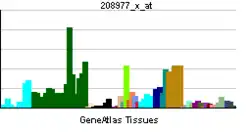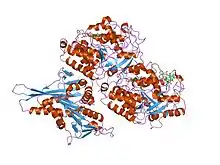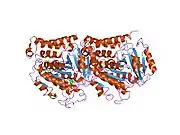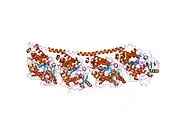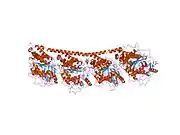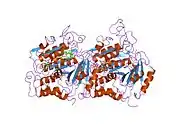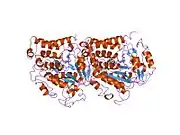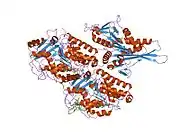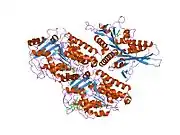Tubulin beta-4B chain
Tubulin beta-4B chain formerly known as tubulin beta-2C chain is a protein that in humans is encoded by the TUBB4B gene.[5][6]
References
- GRCh38: Ensembl release 89: ENSG00000188229 - Ensembl, May 2017
- GRCm38: Ensembl release 89: ENSMUSG00000036752 - Ensembl, May 2017
- "Human PubMed Reference:". National Center for Biotechnology Information, U.S. National Library of Medicine.
- "Mouse PubMed Reference:". National Center for Biotechnology Information, U.S. National Library of Medicine.
- Lewis SA, Gilmartin ME, Hall JL, Cowan NJ (Jul 1985). "Three expressed sequences within the human beta-tubulin multigene family each define a distinct isotype". J Mol Biol. 182 (1): 11–20. doi:10.1016/0022-2836(85)90023-3. PMID 3999141.
- "Entrez Gene: TUBB2C tubulin, beta 2C".
Further reading
- Burgoyne RD, Cambray-Deakin MA, Lewis SA, et al. (1989). "Differential distribution of beta-tubulin isotypes in cerebellum". EMBO J. 7 (8): 2311–9. doi:10.1002/j.1460-2075.1988.tb03074.x. PMC 457095. PMID 2461292.
- Wang D, Villasante A, Lewis SA, Cowan NJ (1987). "The mammalian beta-tubulin repertoire: hematopoietic expression of a novel, heterologous beta-tubulin isotype". J. Cell Biol. 103 (5): 1903–10. doi:10.1083/jcb.103.5.1903. PMC 2114403. PMID 3782288.
- Watts NR, Sackett DL, Ward RD, et al. (2000). "HIV-1 Rev Depolymerizes Microtubules to Form Stable Bilayered Rings". J. Cell Biol. 150 (2): 349–60. doi:10.1083/jcb.150.2.349. PMC 2180222. PMID 10908577.
- Szalay J, Bruno P, Bhati R, et al. (2001). "Associations of PKC isoforms with the cytoskeleton of B16F10 melanoma cells". J. Histochem. Cytochem. 49 (1): 49–66. doi:10.1177/002215540104900106. PMID 11118478.
- Tarazona R, López-Lluch G, Galiani MD, et al. (2001). "HLA-B2702 (77-83/83-77) peptide binds to beta-tubulin on human NK cells and blocks their cytotoxic capacity". J. Immunol. 165 (12): 6776–82. doi:10.4049/jimmunol.165.12.6776. PMID 11120798.
- Walss-Bass C, Xu K, David S, et al. (2003). "Occurrence of nuclear beta(II)-tubulin in cultured cells". Cell Tissue Res. 308 (2): 215–23. doi:10.1007/s00441-002-0539-6. PMID 12037579. S2CID 25518226.
- Krebs DL, Uren RT, Metcalf D, et al. (2002). "SOCS-6 Binds to Insulin Receptor Substrate 4, and Mice Lacking the SOCS-6 Gene Exhibit Mild Growth Retardation". Mol. Cell. Biol. 22 (13): 4567–78. doi:10.1128/MCB.22.13.4567-4578.2002. PMC 133908. PMID 12052866.
- Strausberg RL, Feingold EA, Grouse LH, et al. (2003). "Generation and initial analysis of more than 15,000 full-length human and mouse cDNA sequences". Proc. Natl. Acad. Sci. U.S.A. 99 (26): 16899–903. Bibcode:2002PNAS...9916899M. doi:10.1073/pnas.242603899. PMC 139241. PMID 12477932.
- Chen D, Wang M, Zhou S, Zhou Q (2004). "HIV-1 Tat targets microtubules to induce apoptosis, a process promoted by the pro-apoptotic Bcl-2 relative Bim". EMBO J. 21 (24): 6801–10. doi:10.1093/emboj/cdf683. PMC 139103. PMID 12486001.
- Dozier JH, Hiser L, Davis JA, et al. (2003). "β class II tubulin predominates in normal and tumor breast tissues". Breast Cancer Res. 5 (5): R157–69. doi:10.1186/bcr631. PMC 314434. PMID 12927047.
- Trinczek B, Brajenovic M, Ebneth A, Drewes G (2004). "MARK4 is a novel microtubule-associated proteins/microtubule affinity-regulating kinase that binds to the cellular microtubule network and to centrosomes". J. Biol. Chem. 279 (7): 5915–23. doi:10.1074/jbc.M304528200. PMID 14594945.
- Ota T, Suzuki Y, Nishikawa T, et al. (2004). "Complete sequencing and characterization of 21,243 full-length human cDNAs". Nat. Genet. 36 (1): 40–5. doi:10.1038/ng1285. PMID 14702039.
- Navarro-Lérida I, Martínez Moreno M, Roncal F, et al. (2004). "Proteomic identification of brain proteins that interact with dynein light chain LC8". Proteomics. 4 (2): 339–46. doi:10.1002/pmic.200300528. PMID 14760703. S2CID 8868600.
- Campbell GR, Pasquier E, Watkins J, et al. (2005). "The glutamine-rich region of the HIV-1 Tat protein is involved in T-cell apoptosis". J. Biol. Chem. 279 (46): 48197–204. doi:10.1074/jbc.M406195200. PMID 15331610.
- Gerhard DS, Wagner L, Feingold EA, et al. (2004). "The Status, Quality, and Expansion of the NIH Full-Length cDNA Project: The Mammalian Gene Collection (MGC)". Genome Res. 14 (10B): 2121–7. doi:10.1101/gr.2596504. PMC 528928. PMID 15489334.
- Andersen JS, Lam YW, Leung AK, et al. (2005). "Nucleolar proteome dynamics". Nature. 433 (7021): 77–83. Bibcode:2005Natur.433...77A. doi:10.1038/nature03207. PMID 15635413. S2CID 4344740.
- de Mareuil J, Carre M, Barbier P, et al. (2006). "HIV-1 Tat protein enhances Microtubule polymerization". Retrovirology. 2: 5. doi:10.1186/1742-4690-2-5. PMC 549075. PMID 15691386.
- Giacca M (2006). "HIV-1 Tat, apoptosis and the mitochondria: a tubulin link?". Retrovirology. 2: 7. doi:10.1186/1742-4690-2-7. PMC 549042. PMID 15698476.
- Ahmed M, Forsberg J, Bergsten P (2005). "Protein profiling of human pancreatic islets by two-dimensional gel electrophoresis and mass spectrometry". J. Proteome Res. 4 (3): 931–40. doi:10.1021/pr050024a. PMID 15952740.
External links
- TUBB4B human gene location in the UCSC Genome Browser.
- TUBB4B human gene details in the UCSC Genome Browser.
This article is issued from Wikipedia. The text is licensed under Creative Commons - Attribution - Sharealike. Additional terms may apply for the media files.





